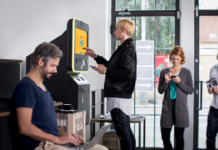CoinGecko hosted its first-ever conference last week ‘GeckoCon – NFTs Gone Wild’. AltcoinBuzz was a partner with CoinGecko to cover the event live!
It's the 3rd and final day of GeckoCon! 🎉
Today we’re exploring nonfungible tokens in sports, arts and also other ways NFTs can be utilized 💪🏽
And don’t forget to stay till the end to find out if you’re one of the lucky winners of our GeckoCon Lucky Draw! 🍀 pic.twitter.com/ewILfY8vUd
— CoinGecko (@coingecko) November 19, 2021
In this article, we are covering the session called “Keeping Your NFTs Secure”. This was a Day 3 session on Friday 18th at 1:15 PM (EST). The host of the session was Dyma Budorin. Dyma Budorin is the CEO of Hacken. Additionally, he supports ethical hacking, cybersecurity, and the crypto world’s accountability and transparency.
Hacken is the world’s leading cybersecurity firm. It specializes in corporate, individual, and crypto exchange security. Hacken has worked with 500+ companies over the last four years, including:
- FTX
- Kucoin
- CoinGecko
- Solana
- Vechain
- Avalanche
- and AirAsia.
In fact, it has become the largest cybersecurity auditor of cryptocurrency exchanges.
Who are hackers?
First, Dyma Budorin described what were hackers looked like in past: “Hackers were the people who always strived to find the innovative use of common things. In the 1960s they were individuals who manipulated phone networks to perform unintended actions. Then, in the 1990s hackers emerged as a novel threat. Later on, in the 2000s massive cyberattacks became a new reality. Lately, the most popular cybercrime was stealing of credit card details”.
He explained what hackers look like today: “Today, you do not need to have super skills to be a hacker. The portrait of a hacker is no longer a super engineer like in the 1960s. Hackers now are amateurs that want easy money. They use simple social engineering techniques to fool you”.
He pointed out what the security risks are for NFT creators (publishers). These are:
- Lack of adequate identity verification
- NFT platforms operating in the so-called grey zone
- A high share of NFTs sold on marketplaces are fake artworks or replicas
- Real authors have to prove their ownership upon noticing their artwork is stolen
He said that everybody needs to know one thing: “Anyone can mint anything. Someone can take a picture of the Mona Lisa and put it for sale at Opensea. Therefore when buying an NFT, it is very important to have confidence in the author”.
He showed possible solutions to the existing risks:
- Marketplaces have to take full responsibility for authors verification
- Cooperation between marketplaces to create a big database for verification purposes
- Cooperation between marketplaces and software giants
- Whitelisting of certain collections
Where to store NFTs?
Dyma Budorin answered this question: “Answer is simple. In NFT wallets. The NFT wallet needs to meet publishers and buyer’s needs:
- Includes functions and widgets exclusive to NFTs
- Ensures cross-chain compatibility
- Supports various platforms
- Has a convenient user interface
- Focuses on security
He pointed out Trust Wallet as the wallet that he uses for storing NFTs.
Can NFT users use hardware wallets to store and secure their NFTs?
He said that you can store your NFTs on a hardware wallet, but it doesn’t make any sense. When you buy NFTs, the main purpose is to show people your NFTs. That’s why it’s much better to keep NFT on your phone.
What precautions do we need to take with browser extension wallets?
Dyma Budorin answered this question: “The main rule is to never download extension wallets from non-official websites. Also, don’t use the same browser for web3 crypto wallet and internet surfing. Use different browsers”.
Follow our new Altcoin Buzz Public NFT Wallet to keep an eye on collections we’re buying, selling, and holding! Use this as a jumping-off point for your research.
0x7304689aAc83c3B236332B0C233878F1819cA89d
And now, you can Join us on Telegram to receive free trading signals.
Finally, for more cryptocurrency news, check out the Altcoin Buzz YouTube channel.



























